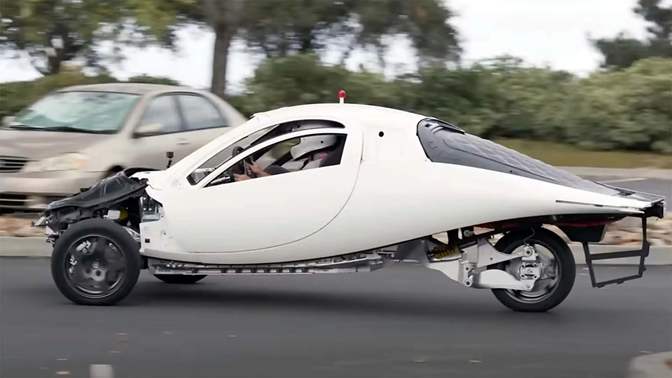Aptera Motors is making headlines as its unique Aptera Solar EV vehicle (EV) nears pre-production. Progress is always promising for this innovative startup, especially since its three-wheeled, solar-assisted EV is one of the most extraordinary designs on the horizon. With a vehicle capable of gaining extra range just by sitting in the sun, Aptera’s vision has the potential to revolutionize the electric vehicle market.

| Key Highlights | Aptera Solar EV |
|---|---|
| Design | Three-wheeled, aerodynamic |
| Solar Capability | Adds up to 40 miles of range per day |
| Price Range | $25,900 to $46,000 |
| Range on a Single Charge | Up to 400 miles |
| Production Target | Estimated 7,000 units in 2025 |
| Funding Secured | $120 million raised since June 2021 |
A Prototype That Moves Us Closer to the Future
Recently, Aptera revealed a significant milestone: the first production-intent prototype of their solar-powered EV. The vehicle shown in their video is a promising glimpse of the final product, though it’s not entirely finished. This prototype lacks several body panels and has a raw, unfinished appearance. Yet, it showcases core elements that are finalized for production, such as the shell, doors, suspension, and an all-new drivetrain.
The Drivetrain Shift: From In-Wheel to Inboard Motors
Initially, Aptera aimed to use in-wheel hub motors, a futuristic choice that would have improved efficiency and handling. However, due to timing constraints, the company pivoted to inboard motors developed by Vitesco Technologies. The chosen Vitesco EMR3 drive unit, comprising the motor, inverter, and reduction gears, now powers the vehicle’s rear axle. This critical change should help keep Aptera on track to meet its long-term production goals, although the impact on efficiency and range remains undisclosed.
Aptera’s solar EV already promises up to 400 miles of range on a full charge for its flagship model, but the real game-changer is its solar array. When fully integrated, the vehicle can potentially add up to 40 miles of daily range just by being exposed to sunlight. This feature is ideal for those who travel short distances regularly, as it may drastically reduce the need for frequent charging.
Facing Challenges: Delays and Financial Struggles
Despite the exciting updates, Aptera has faced its fair share of obstacles. Production has been delayed multiple times, and the company’s timeline for vehicle delivery remains uncertain. Originally, Aptera aimed to start delivering its solar EVs in 2024. However, with ongoing delays, meeting this goal appears increasingly challenging.
Earlier this year, Aptera’s production plans hit a major roadblock when they ran out of funds. While they didn’t confirm an official delay, they did indicate that they needed additional capital to begin full-scale manufacturing. The good news is that they received a significant financial boost from U.S. Capital Global, which invested $60 million, bringing Aptera’s total funding to $120 million since mid-2021. Still, the question of whether this is sufficient to kickstart production remains.
Building Investor Confidence and Securing Preorders
In an attempt to reassure investors and attract new backers, Aptera highlighted the financial potential of its unique EV. The company has accumulated 48,000 preorders, which, if fulfilled, could generate an impressive $1.7 billion in revenue. The solar EV is priced between $25,900 and $46,000, depending on the configuration, and the first 2,000 units will be part of the premium “First Edition” lineup.
Aptera’s announcement emphasizes that the Vitesco drive unit is crucial for keeping their ambitious plans on track. The new technology ensures that the company can aim for vehicle production by 2025. As Aptera stated, delivering these innovative vehicles is vital not only for their shareholders but also for the future of solar-powered transportation.
What’s Next for Aptera?
Before the solar EV can hit the roads, Aptera must finish testing its pre-production prototype. The current focus is on refining the vehicle’s performance and ensuring all systems, including the newly integrated drivetrain, work seamlessly. The company will then move on to installing the solar panels, glass, interior features, and advanced technology required for a complete, road-ready vehicle.
The company is also racing against time to integrate these elements and begin mass production. According to Aptera’s latest updates, early production phases have been funded through their Accelerator Program. However, they are transparent about needing additional investments to sustain manufacturing and deliver EVs to customers.
A Revolutionary Concept with Promising Potential
Aptera’s solar EV is more than just an electric car; it’s a glimpse into a sustainable future where vehicles can self-charge to some extent. While it’s still too early to know if Aptera will deliver on its ambitious promises, the concept has already generated considerable interest. The idea of a vehicle that can add miles of range simply by being exposed to sunlight is undeniably appealing.
In the coming years, the automotive world will be watching closely to see if Aptera’s vision comes to life. If successful, this solar-powered EV could redefine what we expect from electric vehicles and set new standards for efficiency and environmental impact.
A Beacon of Hope for Solar-Powered Mobility
Aptera’s journey has been anything but easy, with financial and technical hurdles along the way. Yet, the company’s determination and innovative approach keep it in the spotlight. While the 2025 production goal is ambitious, the recent advancements and significant investments bring hope that Aptera’s solar EV will soon be more than just a dream.
Related Post
